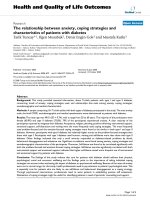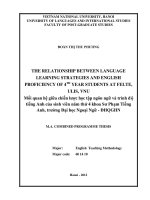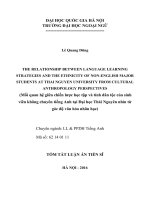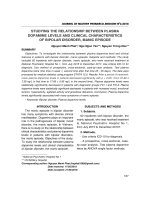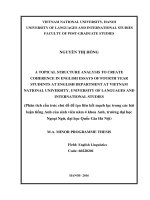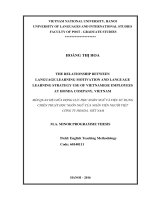The relationship between language learning strategies and English proficiency of 4th year students at felte, ULIS, VNU
Bạn đang xem bản rút gọn của tài liệu. Xem và tải ngay bản đầy đủ của tài liệu tại đây (139.79 KB, 7 trang )
The relationship between language learning
strategies and English proficiency of 4th year
students at felte, ULIS, VNU
Mối quan hê
̣
giư
̃
a chiến lươ
̣
c ho
̣
c tâ
̣
p ngôn ngư
̃
v trình độ tiếng Anh của sinh viên năm thứ 4
khoa Sư Phạm Anh, trường Đại học Ngoại Ngữ
- ĐHQGHN
Đon Thị Thu Phương
University of Languages and International Studies
M.A. Thesis. English Teaching Methodology; Mã số: 60 14 10
Supervisor : Dr. Đỗ Tuấn Minh
Năm bảo vệ: 2012
Abstract. This thesis paper begins with the assumption that strategies are integral for the
effectiveness of students’ learning in general and language learning in particular. After
issues of definition as well as classification of learning strategies, and definition as well
as assessment of language proficiency are addressed, there is a review of previous studies
concerning the relationship between language learning strategies and English proficiency
– also the center of this research. As one of the first attempts to investigate this kind of
relationship within the Vietnamese context, this paper utilized the Strategy Inventory for
Language Learning (SILL) (Oxford, 1989) as the basic instrument to investigate the
frequency level of strategy use and a “standard” Ielts test as an assessment tool of
proficiency level among 87 fourth-year students at FELTE, ULIS, VNU. Excel and SPSS
were then employed to examine the relationship between these two variables. Semi-
interviews were also conducted to further investigate key strategies used by participants
and factors which may affect their strategy use. Higher level students reported using a
large number of language learning strategies more frequently than lower level student. A
positive significant relationship was discovered between language learning strategies and
English proficiency. In the mean time, interviews revealed some useful insights regarding
the use of strategies by individuals. For instance, proficient students were inclined to
utilizing learning strategies under the communicative perspective with more focus on
non-academic materials whereas basic students were subject to academic materials within
the scale of university curriculum. The thesis concludes by bringing together the key
findings and suggesting areas for further research.
Keywords. Phương pháp giảng dạy; Tiếng Anh; Chiến lược học tập
Content.
TABLE OF CONTENTS
PAGE
Declaration i
Acknowledgement ii
Abstract iii
List of tables and figures iv
List of abbreviations/ acronyms vi
CHAPTER 1: INTRODUCTION
1.1. Statement of the problem and rationale for the study 1
1.2. Aims and objectives of the study 4
1.3. Scope of the study 5
1.4. Organization of the study 5
CHAPTER 2: LITERATURE REVIEW
2.1. Learning strategies 7
2.1.1. Definition of learning strategies 7
2.1.2. Classification of learning strategies 10
2.2. Language Proficiency 18
2.2.1. Definition of language proficiency 18
2.2.2. The Common European Framework of Reference for Languages 20
2.3. Language learning strategies and English proficiency 24
CHAPTER 3: METHODOLOGY
3.1. Selections of subjects 28
3.2. Data collection instruments 28
3.2.1. Ielts Test 29
3.2.2. Questionnaires 29
3.2.3. Interviews 31
3.3. Procedures of data collection 32
3.4. Procedures of data analysis 34
CHAPTER 4: RESULTS AND DISCUSSION
4.1. Frequency of language learning strategy use 36
4.2. The correlation between students’ language learning strategies and their English
proficiency 46
4.3. Key strategies and potential factors affecting strategy use 48
CHAPTER 5: CONCLUSION
5.1. Major findings of the study 69
5.2. Contributions of the study 71
5.3. Limitations of the study 72
5.3. Suggestions for further research 73
REFERENCES 74
APPENDICES I
References.
Adbullah, G. & Seyyed, A.M. (2012), Do Language Proficiency Levels Corresponds to
Language Learning Strategy Adoption?, English Language Teaching, 5 (7), pp.110-
122.
Brumfit, C. (1984), Communicative Methodology in Language Teaching, Cambridge
University Press, Cambridge.
Çaliskan, M., Sünbül, A.M. (2011), The Effects of Learning Strategies Instruction on
Metacognitive Knowledge, Using Metacognitive Skills and Academic Achievement
(Primary Education Sixth Grade Turkish Course Sample), Kuram ve Uygulamada
Egitim Bilimleri, 11 (1), pp.148-153.
Chamot, A. U. (2004), Principles of language learning and teaching, Pearson Education,
USA.
Dreyer, C., Oxford, R. L. (1996), Prediction of ESL proficiency among African speakers
in South Africa. In R.L. Oxford (Ed.), Language learning strategies around the
world: Crosscultural perspectives, pp. 61-74), University of Hawaii Press, Manoa.
Farhady, H. (1982), Measures of language proficiency from the learners' perspective,
TESOL Quarterly, 16, pp.43-59.
Feng, C. (2010), A correlational Study of Language Learning Motivation and Strategies
of Chinese Undergraduate, Canadian Social Science, 6 (4), pp. 202-209.
Field, A. (2005), Discovering Statistics Using SPSS, SAGE, London.
Gass, S., Mackey, A. (2007), Data elicitation for second and foreign language research,
Lawrence Erlbaum Associates, New Jersey.
Green, J. M., Oxford, R. (1995), A Closer Look at Learning Strategies, L2 Proficiency
and Sex, TESOL Quarterly, 29 (2), pp. 261-297.
Griffiths, C. (2003), Language learning strategy use and proficiency: The relationship
between patterns of reported language learning strategies (LLS) use by speakers of
other languages (SOL) and proficiency with implications for the teaching/ learning
situation, Department of Education, University of Auckland.
Griffiths, C. (2004), Language Learning Strategies: Theory and Research. School of
Foundations Studies, AIS St Helens, Auckland, New Zealand, pp. 1-25.
Hismaoglu, M. (2000), Language learning strategies in foreign language learning and
teaching, The Interner TESL Journal, 6 (8).
Hsiao, T. Y., Oxford, R. L. (2002), Comparing theories of language learning strategies: A
confirmatory factor analysis, Modern Language Journal, 86, pp. 368-383.
Jie, L., Xiaoqing, Q. (2006), Language Learning Styles and Learning Strategies of
Tertiary Level English Learners in China, Regional Language Center Journal, 37
(1), pp. 67-90.
Larsen-Freeman, D. (1991), Second Language Acquisition Research: Staking Out the
Territory.,TESOL Quarterly, 25 (2), pp.315-350.
Mayer, R. (1988), Learning strategies: An overview. In Weinstein, C., E. Goetz, & P. 30
Alexander (Eds.), Learning and Study Strategies: Issues in Assessment, Instruction,
and Evaluation (pp. 11-22), Academic Press, New York.
McDonough, J., McDonough, S. (1997), Research method for English language teachers,
Arnold, London.
Nisbet, D., Tindal, E., Arroyo, A. (2005), Language Learning Strategies and English
Proficiency of Chinese University Students, Foreign Language Annals, 38 (1), pp.
100-107.
Nunan, D. (1989), Understanding language classrooms, Prentice Hall, New York.
Olga, L. (2003, Learning Strategies: Tracing the Term, Universidad Santo Tomas, pp. 1-
32.
O’Malley, J.M., Chamot, A.U. (1990), Learning strategies in second language
acquisition, Cambridge University Press, Cambridge.
O’Malley, J. M., Chamot, A. U., Stewner-Manzanares, G., Russo, R. P., Kupper, L.
(1985), Learning strategies used by beginning and intermediate ESL students,
Language Learning, 35, pp. 21-46.
Oxford, R. L. (1985), A new Taxonomy for second language learning strategies, Eric
Clearinghouse on Languages and Linguistics.
Oxford, R. L., Crookall, D. (1989), Research on Language Learning Strategies: Methods,
Findings, and Instructional Issues, The Modern Language Journal, 73 (4), pp. 404-
419.
Oxford, R. L. (1990), Language learning strategies: What every teacher should know?,
Heinle & Heinle, Boston.
Oxford, R. L. (2001), Language learning styles and strategies, In M. Celce-Murcie (Ed.),
Teaching English as a second or foreign language, pp. 359-366, Heinle & Heinle,
Boston.
Oxford, R. L. (2003a), Language learning styles and strategies: An overview, GALA, pp.
1-25.
Oxford, R. L. (2003b), Language learning styles and strategies: Concepts and
relationships, IRAL, 41, pp. 271-278.
Park, G. (1997), Language learning strategies and English proficiency in Korean
university students, Foreign Language Annals, 30, pp. 211-221.
Peacook, M., Ho, B. (2003), Student language learning strategies across eight disciplines,
International Journal of Applied Linguistics, 13, pp. 179-200.
Radha, N. (2009), Learning Strategy Research – Where Are We Now?, The Reading
Matrix, 9 (2), pp. 132-149.
Rahimi, M. (2004), An investigation into the factors affecting Iranian EFL students’
perceived use of language learning strategies, Doctoral dissertation, Shiraz
University Iran.
Rahimi, M., Riazi, A., Saif, S. (2004), An investigation into the factors affecting the use
of language learning strategies by Persian EFL learners, RCLA-CJAL, pp. 31-60.
Rigney, J.W. (1978), Learning strategies: A theoretical perspective, In H F O’Neil
(Jr)(ed), pp. 165-205.
Rubin, J. (1975), What the good language learner can teach us, TESOL Quarterly, 9, pp.
41-51.
Rubin, J. (1987), Learner strategies: Theoretical assumptions, research history and
typology, In A.L. Wenden, and J.Rubin (eds), Learner strategies in language
learning, Prentice-Hall, Englewood Cliffs, NJ, pp.15-30.
Saricoban, A., Saricaoglu, A. (2008),The effect of the relationship between learning and
teaching strategies on academic achievement, Novitas-ROYAL, 2 (2), pp. 162-175.
Stern, H. H. (1975), What can we learn from the good language learner?, Canadian
Modern Language Review, 34, pp. 304-318.
Vann, Roberta J., Abraham, R.G. (1990), Strategies of Unsuccessful Language Learners,
TESOL Quarterly, 24 (2), pp. 177-198
Wenden, A. (1998), Learner Strategies for Learner Autonomy, Prentice Hall, Great
Britain.
Wenden, A .L. (1991), Learner strategies for learner autonomy, Prentice Hall, UK.
Wu, K. (2010), The Relationship between Language Learners’ Anxiety and Learning
Strategy in the CLT Classrooms, International Education Studies. 3 (1), pp. 174-
191.
